Samsung Electronics Bundle
Who Really Owns Samsung Electronics?
Unraveling the intricate ownership of Samsung Electronics, a global technology titan, is key to understanding its strategic maneuvers and long-term vision. The 2020 succession following Chairman Lee Kun-hee's passing highlighted the complexities of Samsung Electronics SWOT Analysis, cross-shareholdings, and the Lee family's influence. This deep dive into Samsung's ownership structure reveals critical insights for investors and business strategists alike.
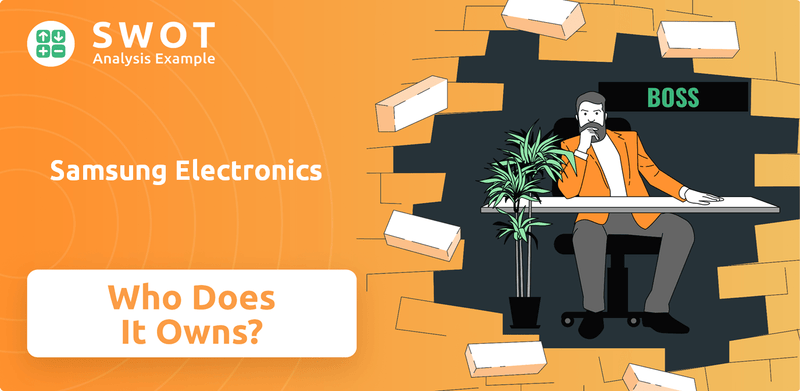
From its humble beginnings in 1969 as Samsung Electric Industries, the company has grown into a powerhouse. Understanding who owns Samsung is crucial, especially considering its substantial impact on South Korea's economy and the interests of its many shareholders. This exploration will examine the evolution of Samsung Electronics ownership, from its founding to its current status as a global leader, analyzing the key players and the dynamics of control within the Samsung corporation.
Who Founded Samsung Electronics?
The story of Samsung Electronics begins with its establishment on January 13, 1969. It emerged as a subsidiary within the larger Samsung Group, a conglomerate founded by Lee Byung-chull in 1938. Initially focused on trading goods like dried fish and noodles, the group's foray into electronics marked a significant shift.
Lee Byung-chull, new to the electronics industry, received guidance from Toshio Iue, the founder of Sanyo. This collaboration was crucial in setting the stage for the company's future in the tech world. The subsequent joint venture with Sanyo and Sumitomo Corporation in December 1969, named Samsung-Sanyo Electric, is considered the direct predecessor of today's Samsung Electronics.
This joint venture initially produced electronic and electrical appliances, including televisions, calculators, refrigerators, air conditioners, and washing machines. The evolution of Samsung Electronics from these humble beginnings to a global technology leader is a testament to its early strategic decisions.
Founded on January 13, 1969, as a subsidiary of the Samsung Group.
Lee Byung-chull founded the Samsung Group in 1938, which later included Samsung Electronics.
Initially focused on trading goods before diversifying into electronics.
Formed a joint venture with Sanyo and Sumitomo Corporation in December 1969.
Produced appliances like televisions, calculators, and refrigerators.
Toshio Iue, the founder of Sanyo, advised Lee Byung-chull.
While specific details on the equity split among the founders and early backers of Samsung Electronics are not readily available in public records, the Lee family has maintained a significant role in the ownership and control of Samsung Group entities. This control is managed through a complex web of cross-ownership structures. For more insights into the company's origins, you can explore the Brief History of Samsung Electronics. As of 2024, the company continues to be a major player in the global electronics market, with its headquarters located in Suwon, South Korea.
Understanding the founders and early ownership provides context for Samsung Electronics' current structure.
- Lee Byung-chull's vision led to the creation of the Samsung Group.
- The joint venture with Sanyo and Sumitomo was crucial for early growth.
- The Lee family's influence remains significant in Samsung ownership.
- Early products laid the foundation for Samsung's diverse product portfolio.
Samsung Electronics SWOT Analysis
- Complete SWOT Breakdown
- Fully Customizable
- Editable in Excel & Word
- Professional Formatting
- Investor-Ready Format
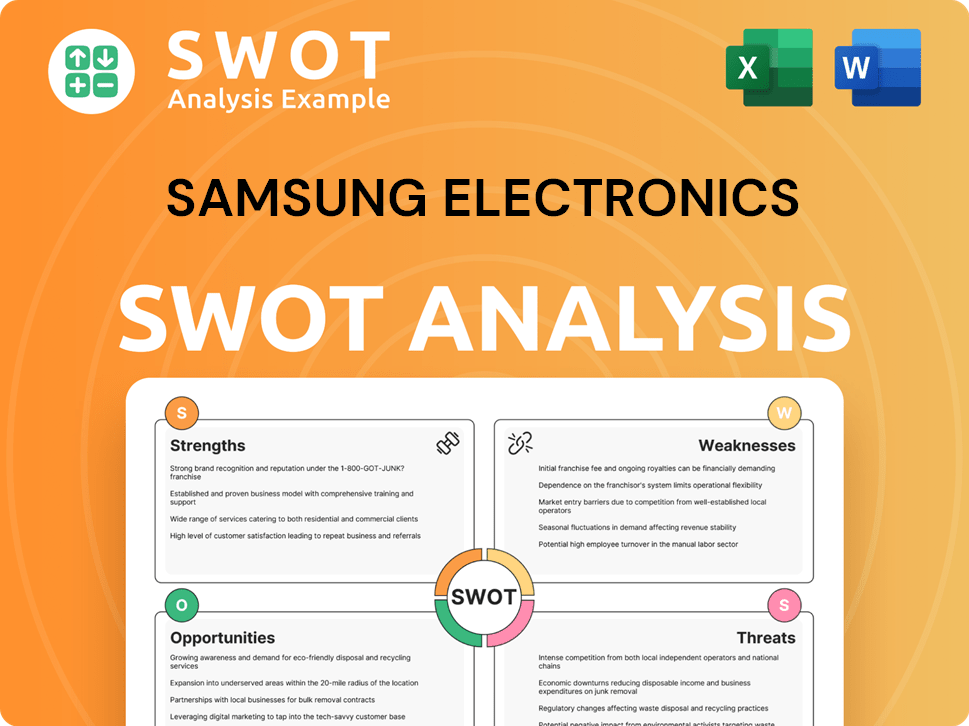
How Has Samsung Electronics’s Ownership Changed Over Time?
The evolution of Samsung Electronics' ownership reflects a complex interplay of foreign investment, domestic institutions, individual investors, and the enduring influence of the founding Lee family. The company's structure, while publicly traded, is deeply intertwined with the broader Samsung Group, creating a unique ownership dynamic. This structure has been a subject of scrutiny and discussion, especially regarding corporate governance and control.
The ownership structure of Samsung Electronics has been shaped by various factors, including the company's growth, market dynamics, and strategic decisions. The Lee family's influence, maintained through cross-ownership among Samsung Group affiliates, has been a key aspect of this evolution. Additionally, the presence of significant institutional investors and the company's listing on multiple stock exchanges have contributed to the diversification and transparency of its ownership.
| Ownership Category | Percentage of Ownership | As of |
|---|---|---|
| Foreign Investors | 57.0% | Latest Available Data |
| Domestic Institutions | 21.0% | Latest Available Data |
| Individual Investors | 17.0% | Latest Available Data |
| Treasury Shares | 5.0% | Latest Available Data |
The Lee family's control over Samsung Electronics is primarily exerted through its stakes in key subsidiaries. For example, Samsung Life Insurance Co., Ltd. held 7.63% of Samsung Electronics' common shares as of May 20, 2025, while Samsung C&T Corporation held 4.47%. Lee Jae-yong, the current executive chairman, indirectly increases his control through his holdings in these subsidiaries. Major institutional shareholders include the National Pension Service of Korea (6.48% as of December 30, 2024) and BlackRock, Inc. (5.00% as of April 29, 2025). Understanding the Growth Strategy of Samsung Electronics provides further insights into the company's trajectory and the influence of these ownership dynamics.
Samsung Electronics' ownership structure is a blend of foreign and domestic investors, with significant influence from the Lee family.
- Foreign investors hold the majority stake.
- The Lee family maintains control through cross-ownership within the Samsung Group.
- Major institutional investors include the National Pension Service of Korea and BlackRock, Inc.
- The company is listed on the Korea Exchange, London Stock Exchange, and LuxSE.
Samsung Electronics PESTLE Analysis
- Covers All 6 PESTLE Categories
- No Research Needed – Save Hours of Work
- Built by Experts, Trusted by Consultants
- Instant Download, Ready to Use
- 100% Editable, Fully Customizable
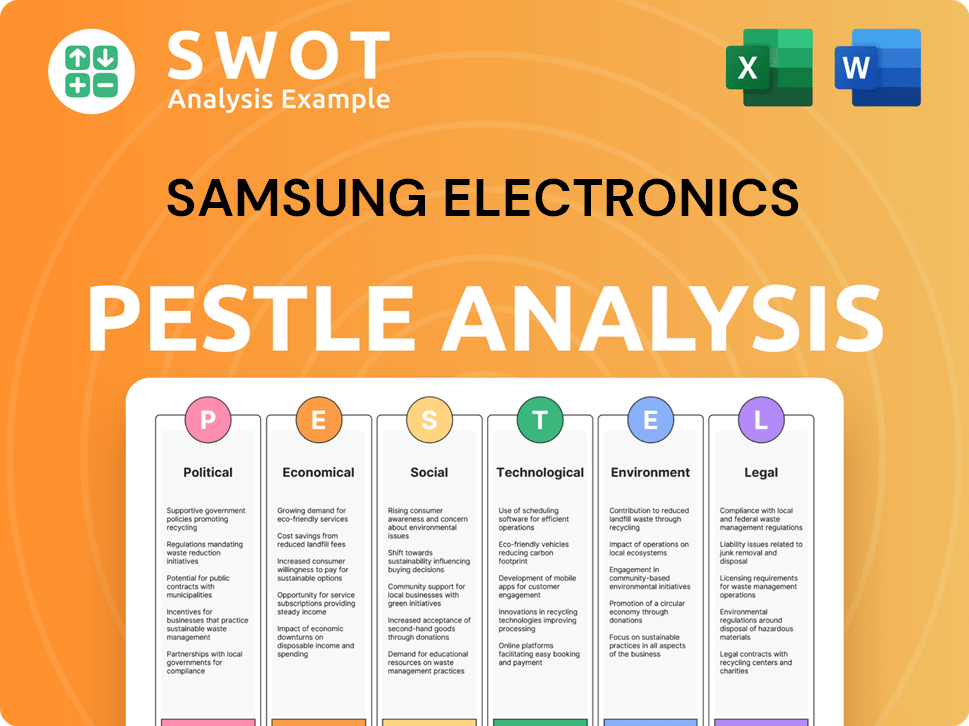
Who Sits on Samsung Electronics’s Board?
As of December 2024, the Board of Directors of Samsung Electronics comprised three Executive Directors and six Independent Directors. This structure ensures an Independent Director majority, promoting independence and transparency. Han-Jo Kim, an Independent Director, has chaired the Board since 2022. The Executive Directors include Jong-Hee Han, Tae-Moon Roh, and Jung-Bae Lee. The Independent Directors are Han-Jo Kim, Jun-Sung Kim, Eunnyeong Heo, Myung-Hee Yoo, Je-Yoon Shin, and Hye-Kyung Cho. Mr. Je-Yoon Shin, appointed in March 2024, brings expertise in economic policy, finance, and fiscal affairs. Furthermore, Dr. Young-Hyun Jun was nominated for appointment as a new Independent Director in February 2025, to strengthen semiconductor expertise.
The board's composition reflects a commitment to diverse expertise and independent oversight, crucial for navigating the complexities of the global technology market. This structure is designed to enhance corporate governance and protect the interests of all Samsung Electronics shareholders.
| Director Category | Name | Role |
|---|---|---|
| Executive Director | Jong-Hee Han | Executive Director |
| Executive Director | Tae-Moon Roh | Executive Director |
| Executive Director | Jung-Bae Lee | Executive Director |
| Independent Director | Han-Jo Kim | Chairman |
| Independent Director | Jun-Sung Kim | Independent Director |
| Independent Director | Eunnyeong Heo | Independent Director |
| Independent Director | Myung-Hee Yoo | Independent Director |
| Independent Director | Je-Yoon Shin | Independent Director |
| Independent Director | Hye-Kyung Cho | Independent Director |
Samsung Electronics operates under a one-share-one-vote structure. Resolutions at the Annual General Meeting (AGM) are passed by more than half of the votes of the shareholders present and by more than one-fourth of outstanding votes. Despite this system, the Lee family, through interconnected holdings in various Samsung affiliates, effectively controls the Samsung Group, including Samsung Electronics. This cross-ownership structure allows the family to exert significant influence over the company's strategic direction and governance.
Activist investor campaigns have highlighted governance issues within Samsung. In 2016, Elliott Management pushed for ownership structure simplification. More recently, in February 2024, activist funds targeted Samsung C&T Corp., demanding share buybacks and dividend increases.
- Activist campaigns pressure for governance reforms.
- Shareholder activism influences company decisions.
- These campaigns aim to increase shareholder value.
- Such actions can lead to changes in corporate strategy.
Samsung Electronics Business Model Canvas
- Complete 9-Block Business Model Canvas
- Effortlessly Communicate Your Business Strategy
- Investor-Ready BMC Format
- 100% Editable and Customizable
- Clear and Structured Layout
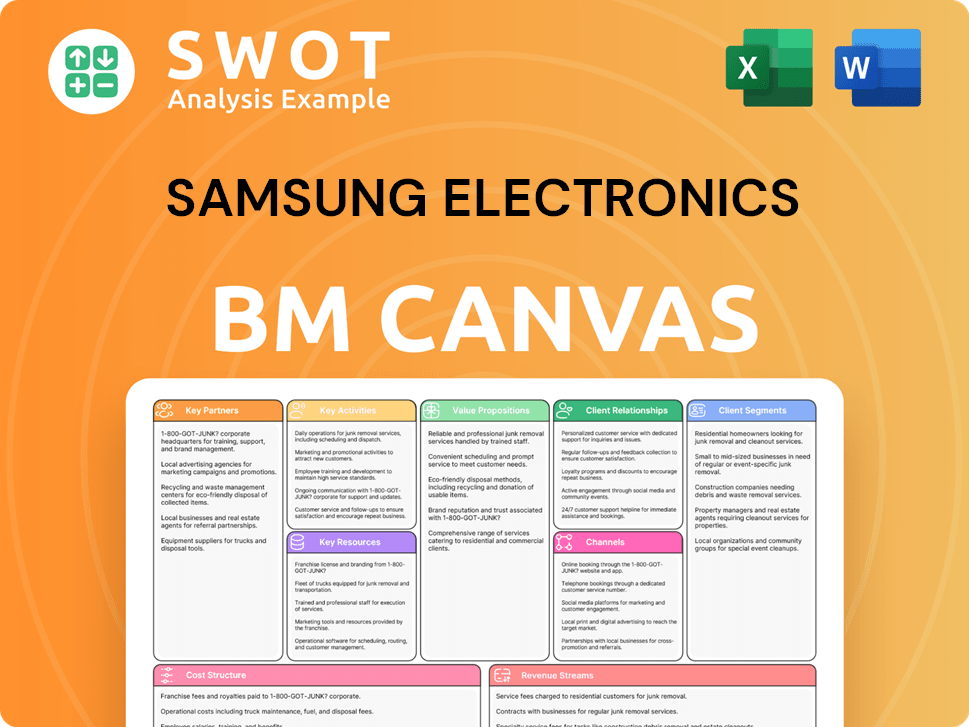
What Recent Changes Have Shaped Samsung Electronics’s Ownership Landscape?
Over the past few years, the ownership structure of Samsung Electronics has seen significant shifts aimed at enhancing shareholder value and adapting to market dynamics. In November 2024, the Board approved a KRW 10 trillion share repurchase program. By February 2025, KRW 3 trillion of common and preferred shares had been repurchased and cancelled. The Board has also decided to repurchase another KRW 3 trillion from the remaining program. For fiscal year 2024, the regular dividend is projected to be KRW 9.8 trillion, or KRW 1,446 per common share and KRW 1,447 per preferred share, subject to approval at the Annual General Meeting (AGM).
This commitment is part of a three-year shareholder return program spanning 2024–2026, which targets a total shareholder return of 50% of free cash flow. Leadership changes also marked this period, with Young-Hyun Jun assuming the role of CEO in March 2025. He has also been the Head of the Device Solutions Division since May 2024, following the passing of co-CEO Han Jong-hee in March 2025.
| Metric | Value | Date |
|---|---|---|
| Foreign Ownership | 49.99% | February 3, 2025 |
| Institutional Ownership | 27.34% | May 31, 2025 |
| Share Repurchase Program (Approved) | KRW 10 trillion | November 2024 |
| 2024 Projected Dividend | KRW 9.8 trillion | FY2024 |
A notable trend in Samsung ownership is the fluctuation of foreign investor stakes. Foreign ownership dipped below 50% for the first time since January 2023, reaching 49.99% as of February 3, 2025. This decline was attributed to decreased semiconductor demand and weak performance, with foreign investors offloading over $15 billion worth of Samsung Electronics stock between September 2024 and January 2025. Institutional ownership was at 27.34% as of May 31, 2025. These trends reflect the dynamic nature of Samsung corporation and its response to market conditions.
Foreign investor stakes have fluctuated, with a notable drop below 50% in early 2025. This shift reflects market volatility and strategic adjustments by investors. Understanding these changes is key for anyone interested in how to invest in Samsung Electronics.
Activist investor initiatives are increasing in South Korea, putting pressure on companies. Samsung is responding with commitments to strategic acquisitions and innovation, especially in AI-driven chip production. This is crucial for Samsung shareholders.
Young-Hyun Jun was appointed CEO in March 2025, leading the company’s strategic direction. This follows the passing of co-CEO Han Jong-hee. For more details, you can read this article about Samsung Electronics.
The company is focused on enhancing shareholder value through share repurchases and dividends. The three-year shareholder return program aims to distribute 50% of free cash flow. This is important for understanding Who owns Samsung.
Samsung Electronics Porter's Five Forces Analysis
- Covers All 5 Competitive Forces in Detail
- Structured for Consultants, Students, and Founders
- 100% Editable in Microsoft Word & Excel
- Instant Digital Download – Use Immediately
- Compatible with Mac & PC – Fully Unlocked
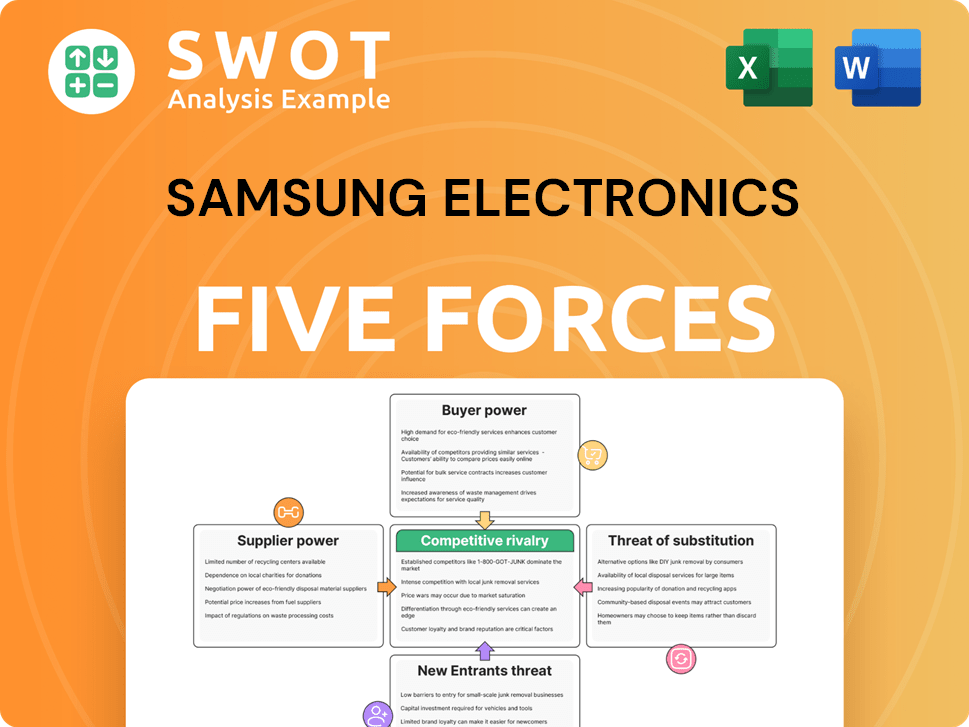
Related Blogs
- What are Mission Vision & Core Values of Samsung Electronics Company?
- What is Competitive Landscape of Samsung Electronics Company?
- What is Growth Strategy and Future Prospects of Samsung Electronics Company?
- How Does Samsung Electronics Company Work?
- What is Sales and Marketing Strategy of Samsung Electronics Company?
- What is Brief History of Samsung Electronics Company?
- What is Customer Demographics and Target Market of Samsung Electronics Company?
Disclaimer
All information, articles, and product details provided on this website are for general informational and educational purposes only. We do not claim any ownership over, nor do we intend to infringe upon, any trademarks, copyrights, logos, brand names, or other intellectual property mentioned or depicted on this site. Such intellectual property remains the property of its respective owners, and any references here are made solely for identification or informational purposes, without implying any affiliation, endorsement, or partnership.
We make no representations or warranties, express or implied, regarding the accuracy, completeness, or suitability of any content or products presented. Nothing on this website should be construed as legal, tax, investment, financial, medical, or other professional advice. In addition, no part of this site—including articles or product references—constitutes a solicitation, recommendation, endorsement, advertisement, or offer to buy or sell any securities, franchises, or other financial instruments, particularly in jurisdictions where such activity would be unlawful.
All content is of a general nature and may not address the specific circumstances of any individual or entity. It is not a substitute for professional advice or services. Any actions you take based on the information provided here are strictly at your own risk. You accept full responsibility for any decisions or outcomes arising from your use of this website and agree to release us from any liability in connection with your use of, or reliance upon, the content or products found herein.